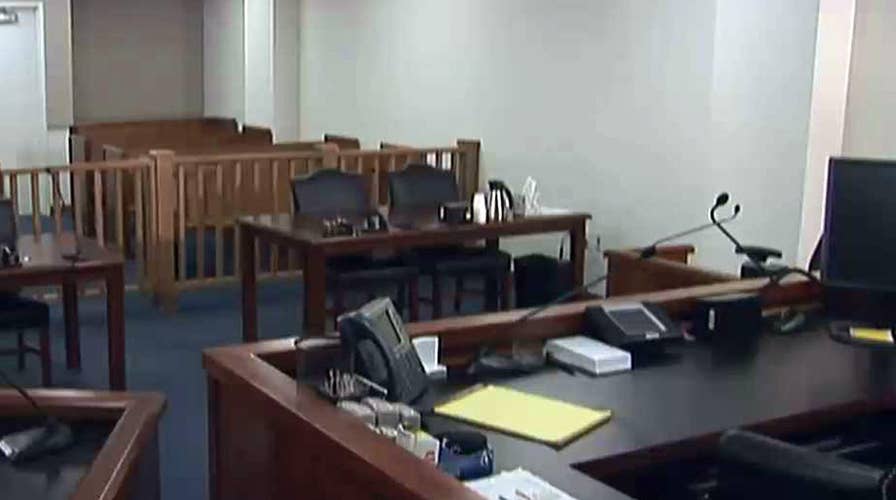“We are legal Cinderellas.”
That’s how U.S. immigration Judge Dana Leigh Marks describes her job these days. She said in the debate over what to do with people in the country illegally, the immigration courts are the forgotten ones.
The system is about to buckle and it has left many wondering just how much more it can handle – as additional federal dollars pour into enforcement, generating additional cases, further straining the courts.
"A long time between a case entering the system and being resolved does not benefit anyone," Marks said.
There are 38,428 cases in the San Francisco district, where Marks serves. Immigration courts across the country are seeing similar – or larger – backlogs.
Marks has been living and working in the crowded trenches for the past 40 years. The first 10 were spent as a young and eager immigration lawyer, before she was given the honor of wearing a black robe. Over the past three decades she has presided over countless cases.
According to data provided by a research center at Syracuse University called TRAC (the Transactional Records Access Clearinghouse), there are currently 542,411 pending cases in the immigration court system. That translates into an average wait time of 673 days, or nearly two years. It’s even longer in some states with high immigrant populations, like in Texas, where the average wait time for a case is 1,076 days, or almost three years.
“We have been a neglected part of the immigration enforcement world for so long,” said Marks, who is also president of the National Association of Immigration Judges, a voluntary organization that represents more than 300 judges. “There are legitimate concerns about how long cases pend in the immigration court.”
LONG LINES, SUSPENDED LIVES: STATISTICS REVEAL IMMIGRATION COURTS ARE DROWNING
Prior to sitting down with Fox News, Marks made clear that her opinions and statements don’t necessarily reflect those of her employer, the federal government. Her top role at the NAIJ allows her to speak more freely about immigration issues than other judges.
Marks’ concerns seem to be growing as quickly as the number of backlogged cases.
If a new case pops up but involves a repeat offender or a defendant who has committed a violent act – it could be fast-tracked and placed ahead of a person with a lower priority on the docket.
That means the legal limbo is always fluctuating. Some cases get pushed back repeatedly, only exacerbating the problem and feeding what seems to be a never-ending cycle.
“The system is broken,” said Rep. Marc Veasey, D-Texas.
The congressman told Fox News that he was shocked after seeing a report from the Migration Policy Institute, a non-partisan think tank, which studies the movement of people. This specific report examined the U.S. Department of Homeland Security’s budget and how those dollars were allocated over a period of time between 2005 and 2012. Veasey said after looking at the numbers more closely he realized the funds were not being distributed in a proportionate manner.
“When you have a system that increases border security funding by about 300 percent and it only increases funding for immigration courts by 70 percent, you have a disaster,” Veasey said.
Veasey says the law enforcement agencies like U.S. Border Patrol and Immigration Customs Enforcement enjoyed large bumps in funding year over year. But the court system somehow didn’t get the same treatment – and seems to have fallen through the cracks.
He has introduced legislation in Washington known as the “End the Backlog Act,” which would temporarily freeze funds for federal law enforcement agencies and re-direct cash to the struggling judicial side.
“No more money for border security until we do something about adding more money for additional judges and additional immigration courts,” he said.
DOJ REPORTEDLY PLANS TO SEND FLEET OF JUDGES TO IMMIGRATION DETENTION CENTERS
Help is starting to arrive and more is on the way, according to the Executive Office for Immigration Review. The EOIR, which oversees the country’s immigration court system, is part of the U.S. Department of Justice. That agency says 12 brand new judges were sworn-in at the beginning of February and more than 50 others are currently going through the hiring process.
“EOIR is continuing to advertise and fill positions nationwide for immigration judges and supporting staff,” said Kathryn Mattingly, a department spokeswoman.
Mattingly says there are currently 301 active judges on the bench and the agency recognizes it must keep hiring to address the mounting caseload. Congress has authorized 374 judgeships across the country – leaving more than 70 vacancies to be filled.
As for addressing the budget and leveling the playing field when it comes to the way dollars are divvied?
“EOIR is working through the Department of Justice to provide necessary information to the Office of Management and Budget, in support of the effort to finalize funding requests, as necessary to continue to advance EOIR’s mission.”
In the meantime, Marks tries to remain positive and optimistic as she grinds through the expanding workload. She’s hopeful a combination of new hires and potential infusion of cash will ease the caseload.
“Many of us still onboard are eligible to retire, but that’s a difficult choice,” Marks said. “Especially as the caseload gets higher and the pressures get greater.”


